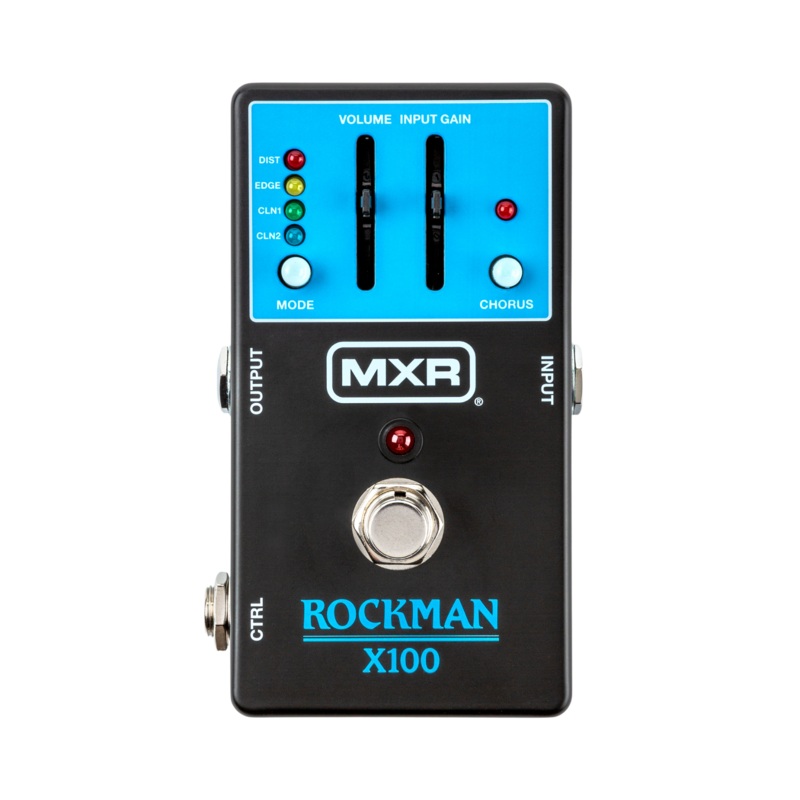 Sale!
Sale! Harnessing some true '80s grit and glimmer, the MXR Rockman X100 Analog Tone Processor is a spiritual revival of one of classic rock's most charming gadgets.In the late 1960s, Tom Scholz began attending the Massachusetts Institute of Technology, writing an
Harnessing some true ’80s grit and glimmer, the MXR Rockman X100 Analog Tone Processor is a spiritual revival of one of classic rock’s most charming gadgets.
In the late 1960s, Tom Scholz began attending the Massachusetts Institute of Technology, writing and playing music in his free time. About ten years later, he had a master’s degree and a platinum-selling record with his band, Boston. His passions for engineering and musicmaking coincided in his founding of his own electronics company, Scholz Research & Development, Inc. This venture brought about many early consumer-grade musical electronics, among them, the Rockman X100. This early headphone amp featured built-in overdrive and modulation effects and proved to be a testament to the arena-minded pop rock that dominated the charts at its time of release.
Today, MXR summons some of that ’80s razzle-dazzle in the Rockman X100 Analog Tone Processor. Recontextualized into a stompbox form, the original sounds of the Rockman X100 headphone amp and signal processor are alive and well for the players of today.
The MXR Rockman X100 is an all-in-one overdrive and modulation effect pedal with design alluding to the original model’s interface. Throwing back to the early SR&D design, this Rockman features two buttons, two sliders, and one footswitch. From here, the whole experience blooms into a vintage-style pedal ready for action.
At its base, the MXR Rockman X100 features four drive modes. The four modes are laid out simply, accessed by the Mode toggle on the pedal’s left side. The modes shake out as such:
There’s more to the Rockman than four distortion modes, however. You might notice the two sliders that take the place your pedal’s knobs are usually in. Let’s not panic, rather, let’s dig in.
The two sliders of the Rockman control volume and input gain, respectively. Your volume slider will operate as you would expect, push up for more volume, pull back for less. This control interacts with the other slider, the input gain control. Your input gain slider will adjust how your incoming signal will interact with the Rockman’s four tone modes. If you raise the input gain slider, you’ll get a more compressed and sensitive sound (which is particularly responsive to the Rockman’s Edge mode).
There’s one more function to the Rockman that gives it that ’80s pizzazz: a bucket brigade chorus. The Rockman actually uses the same MN3007 bucket brigade chip found in the original headphone amp, ensuring its authenticity as an ’80s relic. Click on the chorus effect and hear the lush sounds of arena rock twist and swirl around your clean or driven signals.
The Rockman X100 runs on standard nine-volt power and can be powered with your usual center-negative tip power supply. It features buffered bypass switching and can be run in stereo through accessing its internal mono/stereo output switch. For those who can’t get enough of the classic ’80s arena sound, the MXR Rockman X100 is your ticket back to the future.
What’s the best way to describe this experience? Well, it’s more than a feeling.
Cost: $25
Free Shipping
We offer free shipping on orders over $30. Please check the free - shipping eligibility at checkout.
Delivery Time:
It usually takes [3-5] business days for standard shipping. Please note that this is an estimated time frame and may be affected by local holidays, and unforeseen circumstances.
Reviews
There are no reviews yet.